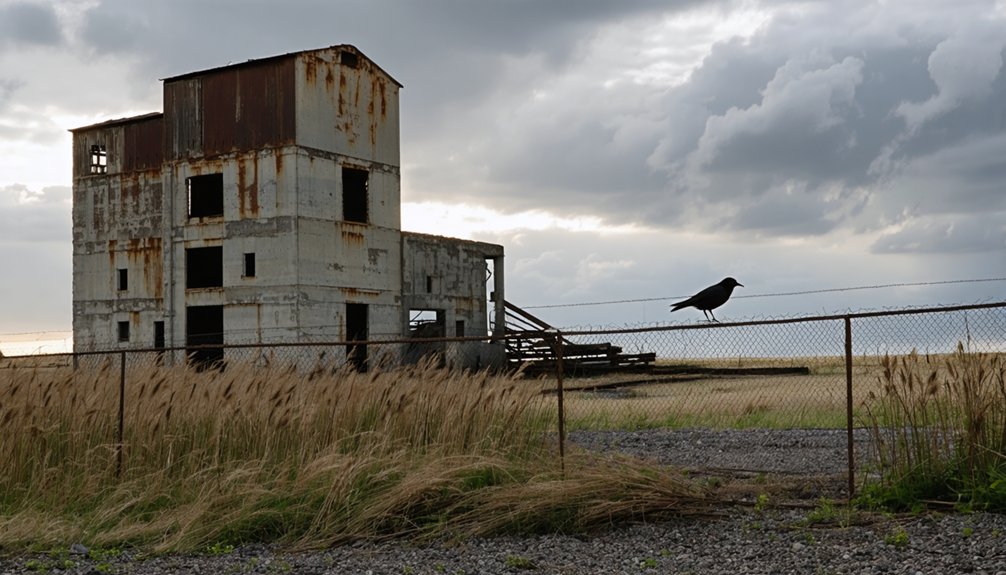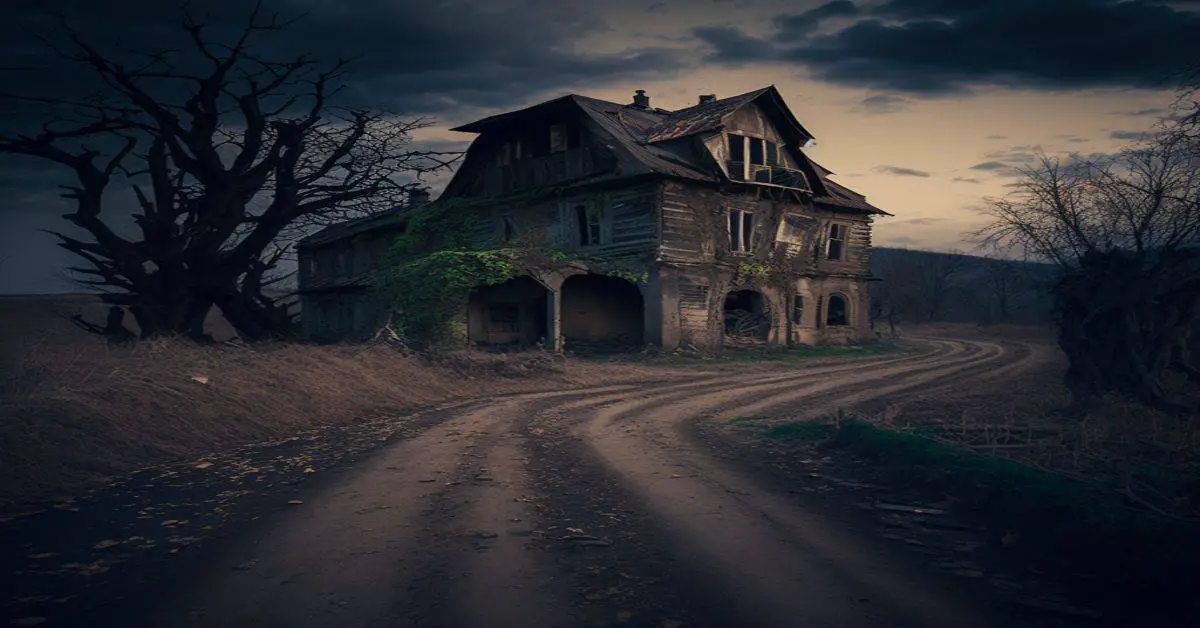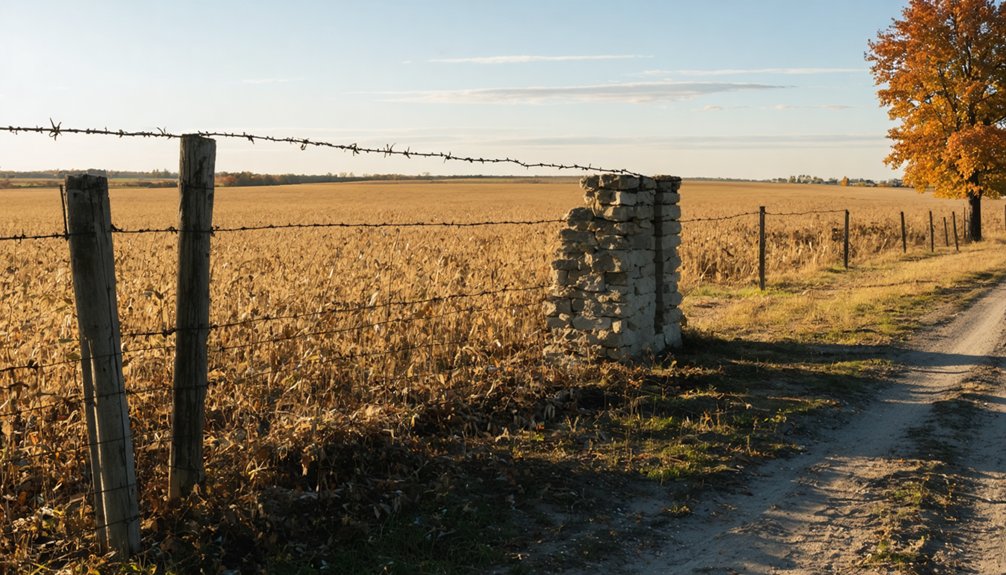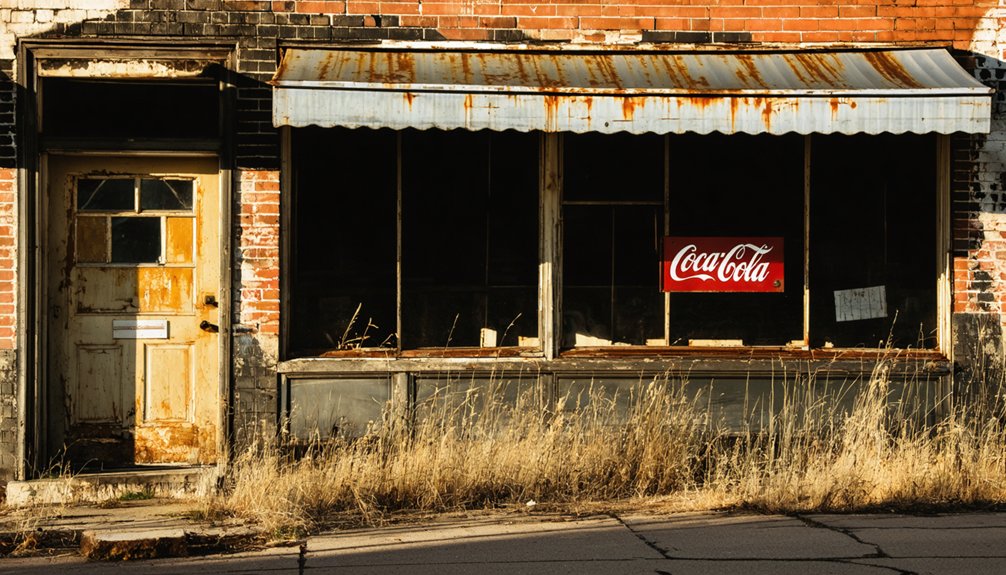You’ll find Clifford Eight along the former Illinois Central Railroad tracks, established in 1903 by Big Muddy Coal and Iron Company. At its peak, this bustling mining town housed 2,000 residents in 400 company-built homes, complete with a company store, school, and Methodist church. After producing nearly 7 million tons of coal over 16 years, the mine’s closure in 1923 led to abandonment. Today, hidden foundations and overgrown rail beds whisper stories of this once-thriving community.
Key Takeaways
- Clifford Eight was a coal mining town established in Illinois during the early 1900s by Big Muddy Coal and Iron Company.
- The town reached its peak population of 2,000 residents living in 400 company-built houses during its mining heyday.
- Over sixteen years, the mine produced 6,749,651 tons of coal before closing in 1923.
- After the mine’s closure in 1923, residents abandoned their homes and businesses, leading to the town’s rapid decline.
- Today, only foundations, an old railroad right-of-way, and a hidden gob dump remain as evidence of this former mining community.
The Birth of a Mining Town
As coal mining swept across southern Illinois in the early 1900s, the Big Muddy Coal and Iron Company established a new company town that would become known as Clifford Eight. Named after Clifford Garrison, whose father O. L. Garrison led the company, this settlement emerged along the boundary of Blairsville Township’s sections 14 and 15.
The town’s mining heritage began when workers struck coal on November 27, 1903, marking the start of industrial impact that would shape the region. The company constructed homes for miners to support its growing workforce. As with many similar locations, careful review of internal links helped historians piece together the town’s history.
You’ll find the mine shaft was strategically placed southwest of section 14’s center. By 1906, the Illinois Central Railroad had extended its reach to Clifford, connecting this budding community to crucial transportation networks.
The town’s establishment reflected the era’s rapid industrialization, with a post office opening in 1905 to serve its growing population.
Life in a Company-Built Community
The lives of Clifford Eight’s residents revolved entirely around the Big Muddy Coal and Iron Company’s influence. You’d find about 2,000 people living in 400 company-built houses during the town’s peak, with community dynamics shaped by the mine’s daily rhythms.
The social infrastructure was surprisingly robust for a company town. You could visit two doctors, get your hair cut at the barbershop, shoot pool at the local hall, or pick up supplies at George Otey’s brick company store. When miners protested high store prices by building their own store, the company denied road access and eventually took over the building.
Despite its company-town status, Clifford Eight offered residents a full complement of services, from medical care to leisure activities.
Children attended the large school while adults worshipped at the Methodist Church. The post office, established in 1905, kept residents connected to the outside world. Like the tragic fate of Cardiff’s miners, a devastating mine explosion killed several workers and marked the beginning of the town’s decline.
Even the smallest details of daily life – from the layout of streets to the size of yard spaces – reflected the company’s careful planning and control.
Mining Operations and Economic Growth
During November 1903, Big Muddy Coal and Iron Company struck its first coal deposits at Mine Number Eight, marking the beginning of significant industrial growth in Clifford. The company’s mining technology advanced rapidly as they expanded operations, establishing vital railway connections with Illinois Central by 1906 to transport coal efficiently.
You’ll find that Clifford’s economic sustainability relied heavily on the mine’s success. The operation created numerous jobs, spurring the development of a thriving village complete with a post office by 1905. Over its sixteen-year operation, the mine achieved total production: 6,749,651 tons.
Despite challenges like company store disputes and access road limitations, the community flourished around the mining operations.
However, this prosperity lasted only until 1923, when the mine’s closure triggered an economic downturn. As families departed and houses were sold off, Clifford’s brief era of mining-driven prosperity came to an end.
Daily Life and Social Fabric
As you explore Clifford Eight’s social fabric, you’d find a close-knit mining community that gathered regularly at the Methodist Church, poolroom, and confectionary.
Living conditions centered around approximately 400 company dwellings, including the distinctive two-room World Fair houses that sheltered the town’s 2,000 residents during its WWI peak.
Your daily routines would have revolved around the brick company store managed by George Otey, where miners and their families collected supplies while exchanging news and strengthening community bonds.
Community Bonds and Gatherings
While mining operations drove Clifford’s economic engine, strong community bonds formed the heart of daily life in this bustling Illinois town.
You’d find yourself drawn into a tight-knit social fabric where community gatherings and social interactions happened naturally throughout the village’s carefully designed spaces.
- The Methodist Church wasn’t just for worship – it served as a central meeting point where families gathered for both religious and social occasions.
- You’d often catch neighbors sharing news at the brick company store, which doubled as the town’s primary social hub.
- The local poolroom and barbershop offered spots where you could unwind and connect with fellow residents.
- Children and families made memories at the confectionery shop, a favorite local meeting place.
- The large school brought families together, hosting both educational and community events.
The town’s population of over two thousand during World War I meant social gatherings were always well-attended and lively affairs.
Mining Camp Living Conditions
Life in Clifford’s mining camp tested the resilience of its residents, who endured cramped company housing and basic living conditions throughout the town’s peak years.
You’d have found yourself in a modest wooden house, tightly packed among your neighbors near the mine shaft. The housing quality was minimal, with basic or non-existent plumbing and heating systems that required constant manual effort to maintain.
Daily life came with significant health risks for you and your family. Coal dust permeated the air, while contaminated water sources and rudimentary sanitation facilities posed ongoing challenges.
The population, sometimes swelling beyond 2,000 residents, strained the already limited infrastructure. With minimal maintenance from the company, you’d have faced the harsh reality that your home was viewed merely as temporary accommodation tied to the mine’s operation. When the mines closed in 1923, many residents had no choice but to abandon their homes entirely.
From Boom to Bust: The Decline
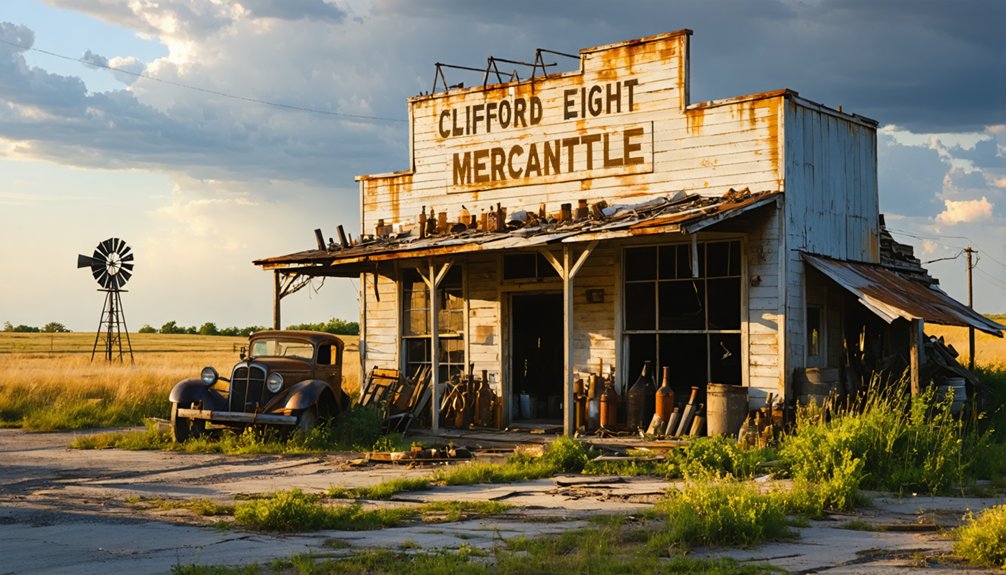
Clifford Eight’s dramatic decline began when the Big Muddy Coal and Iron Company shuttered its Number Eight mine in 1923, eliminating the town’s primary source of employment.
You’d have witnessed an exodus of miners and their families as the population plummeted from its World War I peak of 2,000 residents, leaving behind empty company houses and quiet streets.
Mine Closure Emptied Town
After operating successfully for two decades, the Big Muddy Coal and Iron Company’s mine at Clifford shuttered its operations in 1923, triggering an economic collapse that would empty the town.
The closure exposed the economic vulnerability of single-industry towns, despite the community’s resilience during its prosperous years. The mine was later acquired by Consolidated Coal Company, though this transition couldn’t prevent its ultimate fate.
You’ll find that when the mine closed, the impact was swift and devastating:
- Miners and their families left in search of work elsewhere
- The company store, once bustling with activity, fell silent
- The post office, established in 1905, lost its purpose
- Houses were abandoned as residents relocated
- Local businesses couldn’t survive without the mine’s workforce
Today, only the mine pond and company store foundation remain as silent witnesses to Clifford’s once-thriving mining community.
Population Dwindled After 1923
When the Big Muddy Coal and Iron Company closed its doors in 1923, Clifford’s population entered a dramatic downward spiral that would prove irreversible. The resulting economic downturn triggered an unprecedented population migration as families sought employment elsewhere, primarily in nearby urban centers that offered more stable opportunities.
You’d have witnessed the town’s rapid transformation through the late 1920s as census data revealed a mass exodus of residents. Local businesses shuttered their doors, property values plummeted, and public services dwindled due to depleted tax revenues. This pattern mirrored the struggles seen in communities affected by lax temperance enforcement, which often accelerated economic decline. Much like other American civilizations experiencing drastic changes during this era, the town faced new social perspectives that reshaped its community structure.
The demographic shifted noticeably as younger families departed, leaving behind an aging population. Schools closed due to declining enrollment, while churches and social clubs either disbanded or merged with regional organizations.
Remnants and Ruins Today
The remnants of a once-thriving mining community lie scattered across the Illinois landscape where Clifford Eight once stood.
Today, you’ll find traces of the past as you explore these historic ruins, where nature has steadily reclaimed much of what people left behind.
As you venture through the area, you’ll discover:
- The old company store’s foundation, now serving as a humble hog pen
- School remnants including steps, filler, and a cistern visible across an open field
- A gob dump hidden in the woods, marking the mine’s industrial legacy
- The old railroad right-of-way cutting through the terrain
- Cleaned-up mine sites where workers once toiled underground
The flat topography tells the story of former mining activities, while the quiet rural setting stands in stark contrast to the bustling community that once called this place home.
Legacy in Southern Illinois History
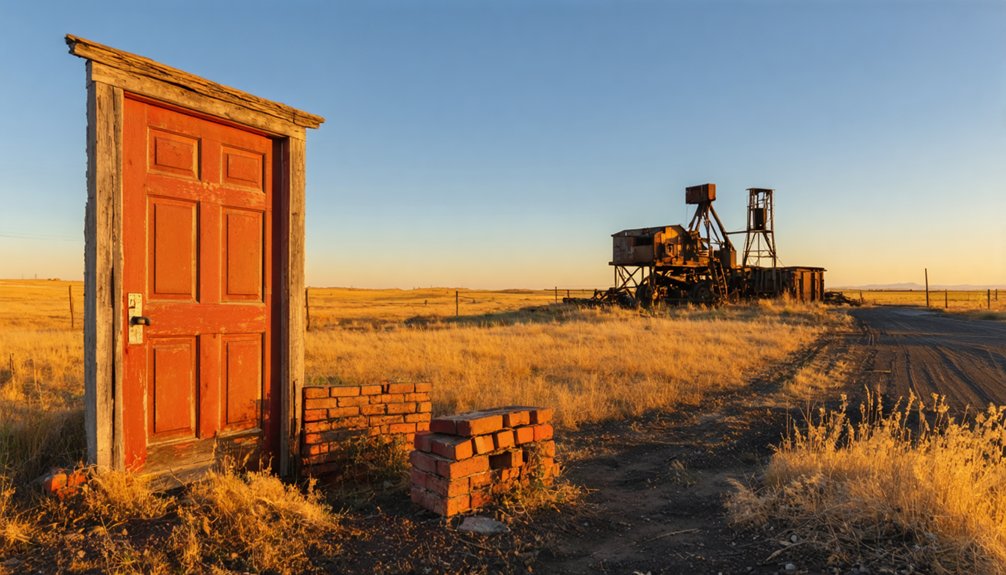
Beyond the physical remnants that dot the landscape, Clifford Eight’s lasting influence on Southern Illinois history runs deep through the region’s industrial and social fabric.
You’ll find its legacy embedded in the area’s cultural identity, from the stories of the Big Muddy Coal and Iron Company’s impact to the social structures that shaped mining communities throughout Williamson County.
The town’s historical preservation efforts remind you of a pivotal era when coal mining transformed Southern Illinois.
Clifford Eight’s connection to national figures like Ethan Allen Hitchcock, its role in railroad expansion, and its peak population of 2,000 residents exemplify how small mining communities contributed to America’s industrial growth.
The town’s rise and decline mirror the broader narrative of early 20th-century coal towns that defined the region’s character.
Frequently Asked Questions
What Happened to the Mining Equipment After the Mine Closed?
You’ll find most mining equipment was either sold for scrap, recycled for parts at other mines, or abandoned on-site, though some pieces were preserved for historical preservation purposes.
Were There Any Major Mining Accidents or Disasters at Mine Number Eight?
You’re looking at 36 deaths from four major gas explosions between 1921-1947, with the worst killing 26 miners in ’47. Mining safety records show frequent accidents from methane, coal dust, and roof cave-ins.
Did Any Notable Historical Figures Ever Visit Clifford During Its Peak?
While company executives visited for business, there’s no evidence of famous visitors beyond Ethan Allen Hitchcock’s business ties. The town’s historical significance centered on local leaders and mining operations.
What Was the Average Wage of Miners Working in Clifford?
You’d find mining wages in Clifford aligned with Illinois coal mines, where workers earned around 90 cents hourly in 1922, dropping to 78 cents by 1926, impacting the entire community’s economic stability.
Where Did Most Residents Relocate to After Clifford Became Abandoned?
Like following a GPS, you’ll find most folks’ residential migration headed to Herrin and Marion, where active mines and better infrastructure provided community impact. Some scattered to nearby farming areas.
References
- https://www.wcihs.org/history/sneeds-clifford-history/
- https://www.wcihs.org/history/clifford-history/
- https://www.youtube.com/watch?v=gM3ZIgtFzBk
- https://en.wikipedia.org/wiki/Clifford
- https://drloihjournal.blogspot.com/2022/09/lost-towns-of-illinois-clifford-illinois.html
- https://northwestchicagoland.northwestquarterly.com/2023/09/27/ghost-towns-of-the-old-northwest/
- https://www.ghosttowns.com/states/il/cliffordeight.html
- https://en.wikipedia.org/wiki/List_of_ghost_towns_in_Illinois
- https://wikiimage.isgs.illinois.edu/ilmines/webfiles/topo-mines/herrin.pdf
- https://www.worldanvil.com/w/vacuum-decay-podcast-rantmanc/a/clifford2C-il-article
